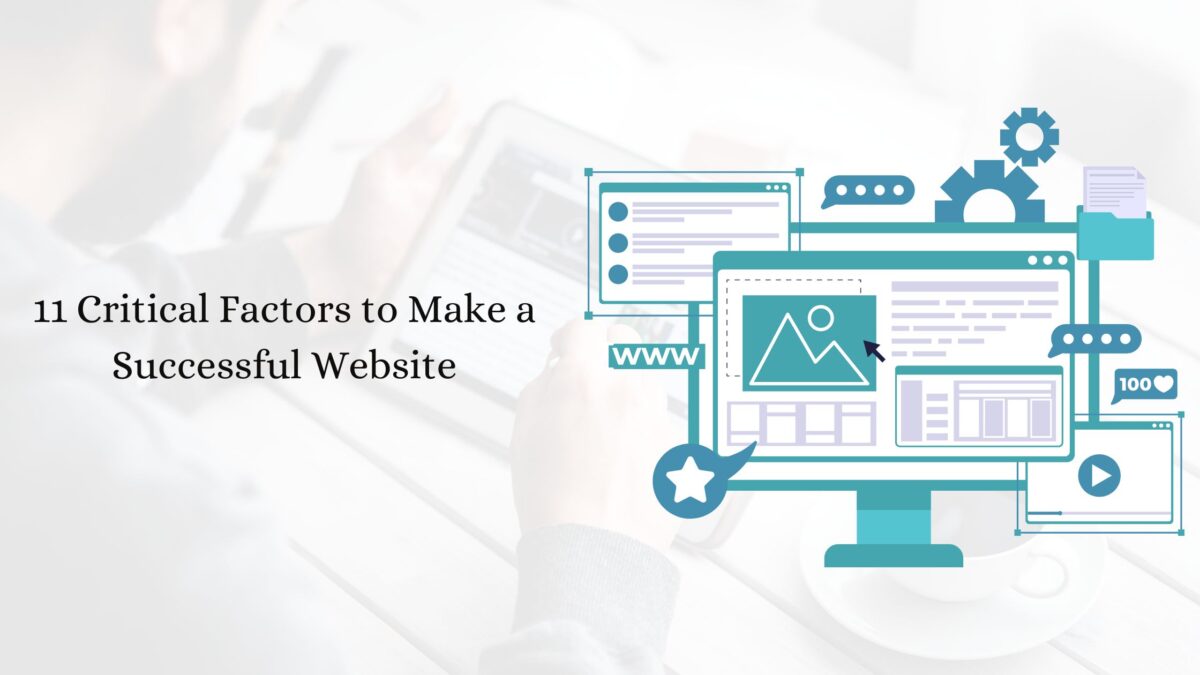11 Critical Factors to Make a Successful Website

Our websites should be made into destinations for marketing and sales campaigns. Knowing these 11 factors will help you drive traffic to your brand.
It doesn’t matter whether you run a small-budget site or a big company; in any situation, a sound web design solutions opens new horizons. An effective website cares for its users and can be used as an advertising hub.
To attract visitors to your website through digital marketing, you should ensure they are satisfied with what they find.
How to Make a Successful Website
Here are some tips for creating an incredible website that inspire and boost sales:
Set up Goals Precisely
It is essential to set out your goals before you embark on the designing and developing process. Are you hoping to create leads, sell stuff, give information, or develop brand awareness? These are some of the main reasons why people want a website. Whatever your objectives, they will dictate every decision about your site’s creation, from choosing its design elements to deciding what content it should have.
When one knows exactly what they want their website to achieve, they can align all aspects towards this single purpose. For instance, if you are interested in generating leads, make sure there are visible call-to-action buttons at strategic points and lead capture forms spread all over the site. If you intend to sell products through it, then the navigation should be seamless, with an easy checkout system design.
Budget Properly
Time, money, and resources are needed to create a successful website. It is important to set aside a realistic amount of money for site development, hosting, maintenance, and continuous updating. If you economize on your budget, the result might be a subpar website that does not fulfill its purpose.
It is necessary to consider the initial and ongoing expenses when planning for a website budget. This includes costs like hosting, domain registration, design work among others which may be used in keeping the site up or promoting it. Paying for quality website designing services and tools from the start can save you money by minimizing costly repairs or redesigns later.
Earn the Trust of Your Audience
Trust is a cornerstone. Customers must have confidence in your website. This may include professional design, clear messaging, customer testimonials, secure payment gateways (if applicable), and transparent privacy and data security policies.
Building trust is not an overnight affair; it requires dedication and time. It begins with great visual appeal while being user-friendly and aligned with your brand identity and values. To make sure that visitors feel safe when they share their information with you, use trust symbols like customer reviews—goods purchased are rated by buyers or industry experts who indicate their opinions on goods bought—recommendations from personalities in your field, and safety badges like, for instance, the one below: paid through Visa.
Find Ways to Stand Out
In a crowded online landscape, it is important to set your website apart from others. This will involve making your sites more specialized in terms of unique selling points that set you apart from your market rivals. Nonetheless, it should be easy for any visitor to differentiate your site through the use of visually appealing images and videos that are catchy.
One of the most effective ways to make yourself stand out is by coming up with a compelling brand story which resonates well with the needs of your target audience. Thus, you must show what makes you different from your competitors and focus on the value proposition of what you offer through products or services. Use attractive graphics and interesting multimedia content as attention grabbing tools for visitors who keep visiting this site or those who are looking for something new.
Focus on Usability & User Experience
A website that is easy to use should retain the attention of website designers in India, especially those specializing in Shopify web design services and php website development services and many more. Remember about navigation, page loading speed, mobile friendliness, and intuitive design, among other things. To improve the general user experience, it might be necessary to identify your customers’ complaints first.
When making website design decisions, one must pay more attention to user experience. Imagine yourself in users’ shoes. How will they navigate through your site? Simplify complicated processes, reduce friction points, and provide clear pathways, which can help users find their desired item faster and easier.
Remember the SEO Fundamentals
SEO is critical for search engines to rank your website highly on SERPs. This would include incorporating keywords into the content, optimizing meta tags and descriptions, using descriptive alt texts for images, and focusing on creating high-quality content that resonates with your target audience.
On-page and off-page tactics are included in optimizing your website for search engines. Besides keyword optimization, build quality backlinks from authoritative websites, optimize site speed and performance, and make browsing mobile-friendly. Regularly keep an eye on the performance of your site’s SEO and tweak it accordingly to either keep or boost rankings.
Optimize Your Landing Pages
Visitors’ conversions into leads or customers depend on the landing page. Have a particular target when making your landing page, capturing email addresses, promoting a product, or encouraging sign-ups. Convincing titles of your content, appealing copies, and precise commands can influence visitors to take the desired actions.
Every landing page should have one value proposition that is not only illuminating but also attractive to your target audience’s needs and wants. Perform A/B tests to try out different things like headline copy, button color, form fields, and others to optimize conversion rates. When you receive performance data on how well these pages are doing, constantly adjust them to remain effective.
Use Your Analytics
To optimize your site’s performance over time, you must make data-driven decisions. For example, using web analytics tools like Google Analytics, one can track various things such as user behavior, traffic sources, and conversion rates. This information will enable you to identify your site’s weaknesses and strengths and how to improve it.
Analyze your analytics reports regularly to see how people interact with your site. Look for trends over time and pinpoint areas where you can make fixes that enhance user experience and yield better results. When planning for the future, try out different approaches and tactics, then measure their impact on the website’s performance.
Learn from Heat Mapping
The use of heat mapping tools will yield valuable insights into how users interact with your website. The maps can identify areas on the page where engagement is highest and spots that could pose user problems. By doing so, you can make more informed design and content choices and improve user experience.
Heat map data contains information about what users click on, how far they scroll down a page, or which elements they interact most with. Using this information, optimize your website layout and prioritize important content while removing distractions or irritants. You can also use heat map data trend analysis to improve your website continuously.
Make Sure Your Website Works All the Time
User experience and credibility are greatly affected by website downtime. Regularly check your site’s performance, server errors, and downtime. Buy good hosting services having backup and recovery mechanisms to minimize breakages and guarantee availability always.
Choose a web host based on its dependability and how often it is online. Choose one with a history of long uptime and responsive customer support for quick problem responses. Set up a monitoring system to alert you if an issue arises and take measures to prevent future downtimes.
Listen & Learn Continuously
The digital scenario keeps on changing and a success of today may be a failure of tomorrow. Be volatile, flexible, open to changes by listening to audience feedback, watching trends in the industry and spying on competition. Your website must keep improving as technology evolves so that it remains effective over time.
Understanding users’ requirements and preferences through questionnaires, polls or Facebook can help you get people’s opinions regularly. It is important to track new technologies or industry breakthroughs that might impact your website strategy hence prepare for such change. A proactive as well as reactive approach will ensure that your website remains a valuable asset delivering business results.
Bottom Line
The website can be successful only if the 11 key factors are focused on. Such a website will be able to convert visitors into customers and contribute to the achievement of your organization’s goals.
If you want to create an effective site, contact ITXITPro- the best web design company in india. Our team is made up of professional specialists who create original Internet solutions as per your business needs and expectations. We make sure that every time we build eye-catching sites employing the latest methodologies and user-centred designs, our clients get better results. Make ITXITPro improve your online representation to become successful in cyberspace. Contact us today to discuss your website designing services and how we can fulfil your dreams.









